In the September 2000 issue (#45) of the unstoppable N64 Magazine, there was a mini-review of Classic Bubble Bobble.
They started said mini-review with a sentence that really got it in one: 'What happened?"
Can we just leave it at that and move on?
[No. - Ed]
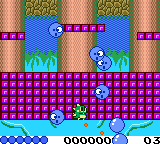
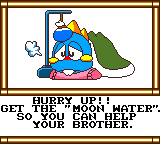
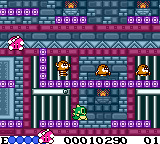
Classic Bubble Bobble is just one of a really weird set of games Taito published (but didn't develop- most of them were handled by Nekogumi, a subsidiary of Jorudan) for the Game Boy Color in the early 2000s, which were all new versions of some of their classic franchises. The first two such titles (this game and Chase H.Q.: Secret Police) had 'Taito Memorial' slapped in-front of their titles in Japan, and the others (such as Elevator Action EX and Front Line: The Next Mission) were stand-alone titles (some of which were distributed in the US by bam! Entertainment and had licenses tacked on, like Front Line becoming Sgt. Rock). Now, what made these titles different from other ports for the GBC (like the Capcom ports of 1942 and Ghosts n' Goblins, or Taito's own Rainbow Islands) was that they weren't ports. They were new games entirely, usually without much to do with the original games beyond the name, and almost all of them were dreadful.
Classic Bubble Bobble was the first of these games, developed by Nekogumi, and it set the tone for the others!

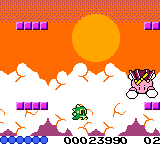
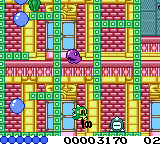
To be fair to it (and this is the only time I'm going to be fair today) the game doesn't try to saddle the formula with ridiculous or ill-conceived new gimmicks- no, Classic Bubble Bobble sticks to the basics of the series. In theory, at least. Those basics are that you're a little bubble-blowing dragon. On each single-screen stage, you have to trap enemies in bubbles, then smash the bubble they're trapped in by whatever means necessary to finish them off. Once all the enemies are dead, it's off to the next screen. As well as that, your dragon can also bounce on top of his own bubbles to reach higher platforms on each stage. That's the formula Classic Bubble Bobble sticks with, and it only adds in two things that appeared in the many sequels- some basic boss fights (the last of which is insultingly easy) and multiple paths (running into little doors will take you to a different stage than if you beat the stage normally).
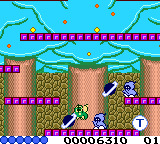
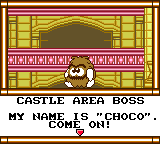

So what's the problem with this one, if it's got all that? Well, it just does it all wrong. It seems like petty, minor shit it gets wrong, but it all piles up. First of all, you can't see enough of the stage- the screen has to scroll, which doesn't work well for a game like this (you can't keep track of every threat this way) and worse, when you're moving down the screen, it lets you see about two blocks below you. This isn't nearly enough, and turns every leap down a platform into a game of chance- will you land safely, or will you collide into an enemy you had no way of knowing was there? What baffles is me is that there's a stage late in the game (Round 38) where there's no floor or platforms, so you fall the entire time (and, naturally, die over and over again because you can't see anything). So, the developers must've known this was a problem. How could they not have known?!
The other major sin is that the physics are all wrong. This isn't a case of me throwing my dummy out the pram and whining "It's not like the others so it SUCKS WAAAAAAAHHHH", because having the correct physics would've made the game far more playable than the broken physics they actually put in. For example, in normal Bubble Bobble games, each stage has a specific air flow for the bubbles which they'll follow, and they'll often bunch up near the top, allowing you to burst them all at the same time. This game breaks this completely- bubbles will usually make their way to the top of the screen then keep going past the ceiling to reappear at the bottom. This means bunching bubbles together is impossible (thus ruining the best way of scoring points and getting EXTEND bubbles) and that the enemies have more time to break free when passing through the ceiling. That's not even the half of it, though. Bubblun now falls v-e-r-y slowly on his way down from a jump, he's much slower than usual, the enemies will constantly pass through walls, the bubble jumping is broken and will happen when you don't want it to, the bonus items barely appear at all, and... I think that's enough. It's a complete train-wreck.
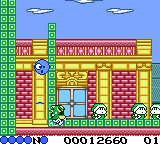
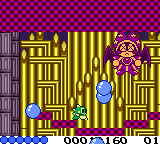
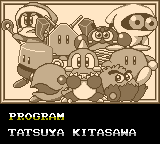
What really vexes me about this game is that it pinches its story and some of its graphics from two previous BB games on the Game Boy- Bubble Bobble and Bubble Bobble Part 2 (it steals the 'enemy in a bubble' sprite and some backgrounds)... So why didn't they just colourise those two? 'Cause they don't suck! Neither were the definitive version of the game (they had the dreaded scrolling) but at least they got the basics right- bubbles bunch up correctly, the bonus items appear more often, the movement physics weren't completely broken, the level designs gave you room to breathe, and they both felt like Bubble Bobble, even with the Game Boy's limitations. All they had to do was tart either of these games up a bit- hell, they could've taken the Micro Machines 1 & 2 - Twin Turbo approach and lumped both games on one cart- and they could've called it a day. But no, we got this, a kick in the nuts of every long-time Bubble Bobble fan. The most damning insult, of course, is that they had the gall to call this 'Classic' Bubble Bobble. You wish it was classic Bubble Bobble, mate.
For taking a big ol' whizz all over a legendary game, Classic Bubble Bobble is awarded...

In a sentence, Classic Bubble Bobble is...
A mess.
Just before we depart, though, there's two more things to share with you.
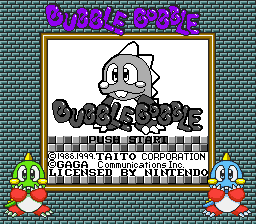

First, the game supports the Super Game Boy, despite being released well after the SNES had kicked the bucket in most Western countries. It was still kinda-sorta on life support in Japan with the Nintendo Power system (which allowed players to download games onto blank carts) but it wasn't in its prime, so it's a bit puzzling why Nekogumi bothered putting a special SGB border in the game. Naturally, it's as lazy as you'd expect- it doesn't give the game a special colour palette, and the art of Bubblun/Bobblun is recycled from the game's ending, but I still bet you never knew this existed, eh?
Second, there's an amusing glitch involving the messed-up bubble physics that allows you to travel up the screen with minimal effort. Facing a wall, blow a bubble, jump on it and then, while holding the Jump button down, keep blowing bubbles. Unlike other, better Bubble Bobble games, the bubble-jump physics are very floaty, which means you'll move upwards until you stop blowing bubbles, making some levels a bit easier (especially if there's enemies at the top of the screen and you need to get to them fast). If you're a professional, you can also do this without the wall- as long as Bubblun is pressed against a solid object (like a platform) when you fire a bubble, he'll keep getting a boost. It's far more amusing than the rest of the game.

And that, ladies and gentlemen, is just the tip of the iceberg when it comes to awful versions of Bubble Bobble.
Let us pray that I never tackle any of the other ones!
Will Bubblun and Bobblun ever get a break on this website? The answer is NO.















